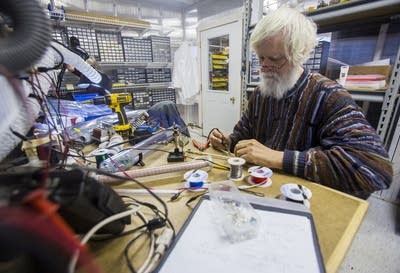Cold fusion a hot idea for Minnesota research into sustainable energy
Go Deeper.
Create an account or log in to save stories.
Like this?
Thanks for liking this story! We have added it to a list of your favorite stories.

A small Minnesota company is gambling that a new line of scientific research could lead to development of a breakthrough alternative energy.
In Pine River, Hunt Utilities Group sits on a 70-acre campus dotted with an eclectic mix of experimental buildings designed to promote sustainable living.
Researchers there are focusing on a theoretical energy source once commonly known as cold fusion. They're asking new questions about a technology widely dismissed by the mainstream scientific community.
• Photo gallery: Look inside the Hunt labs
Turn Up Your Support
MPR News helps you turn down the noise and build shared understanding. Turn up your support for this public resource and keep trusted journalism accessible to all.
Visits to the company, founded by Paul and Lynn Hunt, begin with a tour of their experimental home. A single element from a water heater sends hot water through pipes in the floors. Heavy insulation and passive solar heat keep the cost of heating the 4,000 square-foot house to less than $50 a month.
The Hunt's focus on sustainable living is supported by profits from a wildly successful invention Paul devised in the 1990s. The self-taught inventor patented the "turtle meter," which allows utility companies to remotely read electric power meters.
Hunt sold his invention for tens of millions. His company is now using the money for research and development, searching for the next breakthrough invention to sustain the company and its 20 employees.

That's where cold fusion comes in. The technology was first introduced in 1989 by two scientists who claimed they were able to produce excess heat from an experiment that combined hydrogen and electricity with various metals.
When other scientists were unable to consistently replicate the effect, mainstream scientists largely rejected cold fusion.
When Paul Hunt first started looking into the technology two years ago, he and his son, Ryan, were skeptical.
"Both of us looked at each other here and said 'cold fusion, I thought that was dead. I thought that was fake,'" Hunt said. "We started paying attention to it. And then we started looking at the history of it, and found out that it really is real. It's being done in labs all over the world."

With a degree in chemical engineering from the University of Minnesota, Ryan Hunt is head of research and development at his parent's company.
He stands over a pair of small, transparent tubes containing ceramic structures that hold pairs of hair-thin wires. The apparatus is similar to ones he saw demonstrated by an Italian scientist at a conference in Korea last summer.
Hunt said he and his team achieved the cold fusion effect for the first time just last month.
The same unexplainable effect has reportedly been achieved at more than 100 other laboratories worldwide. Most have ditched the term "cold fusion" in favor of the term "low-energy nuclear reactions."

Hunt Utilities Group has teamed with scientists in Europe to collaborate. They post their data online (Low-energy nuclear reactions) and invite other researchers to review and comment on their methods.
The goal, Ryan Hunt says, is to demonstrate the science well enough to excite other researchers. He believes the technology could potentially heat homes, power cars and replace coal to produce electricity.
"Because the potential upside in the long term is the displacement of all fossil fuels, it would be such a boon for the human race to have such a dense, clean source of energy, that it's real easy to stay motivated on a project like this," he said.
While the federal government is not investing much resources into the technology, scientists at NASA's Langley Research Center have begun studies.
Benjamin Bayman, professor emeritus of physics at the University of Minnesota, does not believe the processes that scientists have achieved are nuclear in nature, but said that the science is probably worth pursuing.
"There are phenomenon going on there that are not properly understood. And so it would be good if we did understand them," Bayman said. "Once we do understand them, there may well be some practical applications."
Company founder Paul Hunt is patient. He thought up his turtle meter idea 25 years before the device became reality. He hopes that low-energy nuclear reactions technology will also result in a long term payoff.
"We know it's a risk, and we think the payback is potentially bigger than the risk, so that's why we're doing it," he said.
Hunt believes in the technology enough to invest more than half a million dollars annually into its research.




